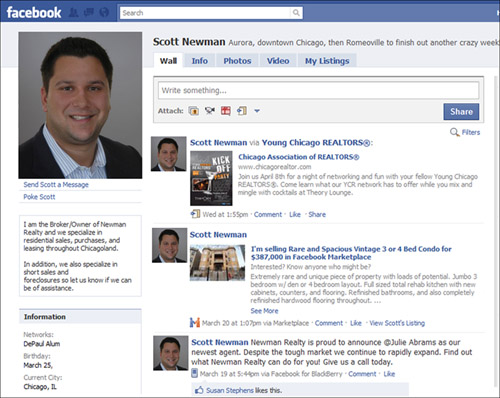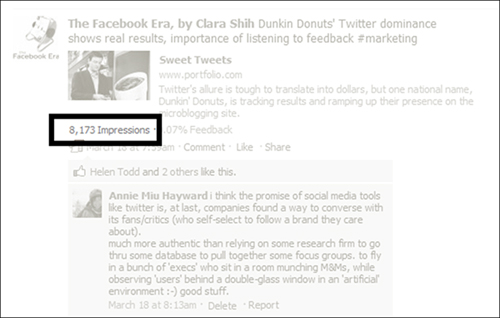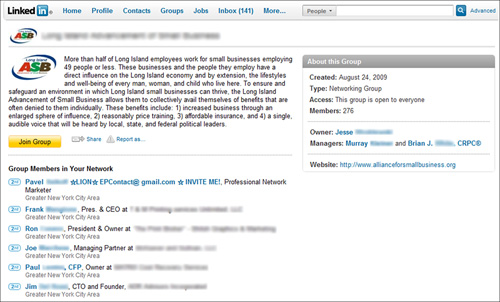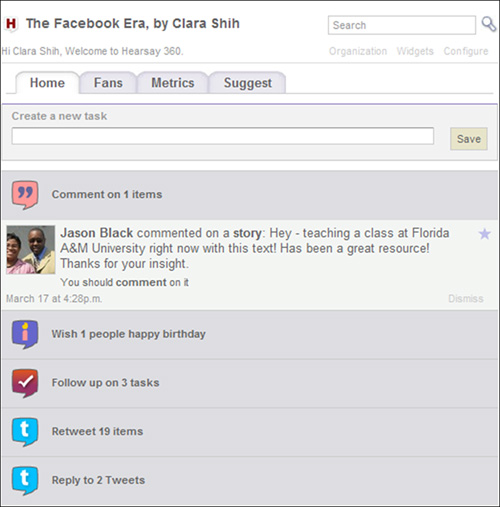13. Advice for Small Business
Some of the tactics and strategies we’ve covered in this book aren’t realistic if you’re a small business owner. You don’t have the time, the budget, or perhaps the need. Many small businesses, especially sole proprietorships, don’t have a dedicated online marketing person, much less the luxury of a dedicated social media manager. I don’t recommend that most small companies invest in building fancy applications or Facebook for Websites integrations unless it’s absolutely core to your business. It’s easy for brands to justify heavy investment in custom apps and creative because they are guaranteed millions of customer impressions and interactions. It’s harder to justify that expense when your customer base is substantially smaller, and you have few resources and many competing priorities.
This chapter is a set of ten quick tips on how to do a lot with a little on the social Web.
1. Start Small
One of the great things about Facebook, Twitter, and LinkedIn is that you can start small and gradually ramp up your investment. They are all free to get started—the biggest cost is your time. Take ten minutes to create a basic profile. If you decide this is where you want to connect with customers and prospects, try to post something on a regular basis. It doesn’t have to be every day—your customers realize that you have a business to run and will respect as little or as much commitment you can make, as long as you are consistent.
In the following guest expert sidebar, we hear from small business owner Amanda Cey on how a small time investment on her part in building out her social network presence has transformed her San Francisco-based event planning and production company.
How I Bootstrapped My Small Business with Social Tools
Amanda Cey
My company, ABCey Events, is an event planning firm serving the San Francisco Bay area. We have produced events for clients including Adobe, Michael Moore, and Razorfish. Every day, we leverage connections across social networks to provide highly targeted direct promotion for clients.
When I first started my business in 2007, all of my sales leads began with a phone call. Finding leads involved calling blindly until I uncovered an opportunity. My introduction to social media was born out of my dissatisfaction with traditional sales methods.
At the time, companies were downsizing, not throwing lavish events. Here I was with limited resources myself, trying to convince others to spend their money. I needed a way to keep my business alive during the economic downturn and an effective yet somewhat less outwardly aggressive strategy.
I decided to grow my presence and visibility utilizing the three key social networks: Facebook, Twitter, and LinkedIn. Through the Social Web, my network has expanded exponentially with each new friend or follower, requiring little traditional marketing work and at no cost! Social media networking has since become our #1 business tool and source of the majority of our leads.
We use Twitter as an interaction tool (see Figure 13.1). We respond even more than we post to show that we are a real-time resource for potential clients. LinkedIn also helps us reach out to professional clientele.
Figure 13.1
Social networking sites like Twitter have become a valuable source of leads and referrals for ABCey Event Production Company.

Reprinted by permission
Our blog content draws in and retains fans and followers. Blog articles are short, smart, and edgy. We have just a few lines to grab the readers’attention and to show that we are savvy of popular culture and the clear experts in event planning. The blog leads the reader to our social media sites. Facebook is a repository for everything about our company, from event pictures to the live comment feed.
But success in our industry does not come solely from behind a keyboard. Active fieldwork, such as attending networking events or arranging face-to-face meetings, is vital to our social media campaigns. Together, we can make a powerful human connection with clients and distinguish ourselves from everyone else.
Amanda Cey (@abceyevents) is owner and founder of ABCey Events Company in San Francisco, California.
2. Consider Using Your Personal Profile Instead of a Facebook Page
Facebook Pages are a good way to create a boundary between your business and personal life, but they also introduce overhead by needing to maintain a separate presence and set of contacts. You could easily double the amount of time and effort when you have a Facebook Page instead of only a personal profile. It might make more sense to stick with only a personal profile in these situations:
• You are a one-man or one-woman show who has deeply personal relationships with your customers.
• You are still on the fence about Facebook and want to test the waters before committing more resources.
• It feels strange to ask your friends and customers to “like” your Page.
• Many of the people who would “like” your Facebook Page are already friends with your personal profile.
• You don’t have anything on your personal profile that is unprofessional or uncomfortable to share.
Figure 13.2 shows a wonderful example from Scott Newman, a top-producing residential real estate agent in Chicago. From Scott’s perspective, he has nothing to hide and wants his clients and prospects to get to know his full personality. Using his profile for his business makes his Facebook presence and client interactions highly personal. Technically, Facebook’s terms of service frown on business activity on personal profiles, but for certain kinds of small business (such as sole proprietorships), as long as you are being authentic to your personality and your friends don’t complain, this setup works well.
Figure 13.2
Scott Newman, broker and owner of Newman Realty in Chicago, Illinois, uses his personal profile to also represent his business. Scott uses a combination of Hearsay 360 to manage client relationships and Oodle Pro to display new listings as a custom tab on his profile.

Reprinted by permission
3. Take Advantage of Location Targeting and Geolocation
If you are a brick-and-mortar business, you should definitely consider location-targeted ads on Facebook that let you reach audiences within a certain city or a 10-, 25-, or 50-mile radius. Not surprisingly, nearly three-quarters of Facebook’s ad revenue last year came from local advertisers. This is perfect for retail stores, salons, spas, restaurants, bars, and other local businesses. If you provide local business-to-business (B2B) services, you can use the geography targeting on LinkedIn DirectAds.
If you are a mobile business, such as a food truck or cart vendor, check out the geolocation features on Twitter, Loopt, Gowalla, and Foursquare that enable you to share your real-time location, or just tweet your location. This is how Los Angeles–based Kogi BBQ has grown to a following of more than 60,000 loyal fans. Fans track the real-time location of Kogi’s Korean–Mexican taco trucks so they know where to pick up their next meal of spicy pork tacos, kimchi quesadillas, and short rib sliders.
4. Build Community
Especially if you decide to create a Facebook Page, use it as an opportunity to build community. Don’t make your Page about you—make it about fans. Extend the face-to-face community you have in your stores to Facebook so that you can forge even stronger customer relationships. Publicize events, seminars, and even little league baseball games that your business is sponsoring via Facebook Events. Afterward, post photos and videos from events on your Page Wall to re-create the experience for anyone who visits your Facebook Page. As we mentioned earlier, it might feel awkward to ask friends and customers to publicly “like” your personal profile. This is another reason to create a Page about your company or community.
The team at Synthesis. net, an indie blog based in Chico, California, has figured this out. They created a Facebook Page, “Life in San Francisco,” about all things San Francisco that has drawn nearly 15,000 fans (see Figure 13.3). In comparison, Synthesis. net’s own Facebook Page has less than 1,000 fans. By making the first Facebook Page about San Francisco, the team is able to engage a much bigger audience while still guiding the conversation on the Page.
Figure 13.3
Synthesis. net’s Facebook Page “Life in San Francisco” has little company branding. This Page has been extremely successful as a grassroots initiative, attracting nearly 15,000 fans and high levels of daily engagement.

5. Build Your Sphere of Influence
For many small businesses, you can’t necessarily dictate when people should buy your product or service—but when they are in the market to buy, you want to make sure that they think of you first. It’s the art of the soft sell, and it’s equally true whether you’re a real estate agent, an insurance agent, a veterinarian, or an auto mechanic. Sometimes you can help stimulate demand by encouraging people to do something that they have been delaying (such as a car repair) with reminders or discounts, but even then a hard sell rarely works.
The power of the social Web is that it enables small business owners to efficiently and effectively build a sphere of influence about their business. By offering valuable knowledge and advice and being genuine, you will slowly build trust and authority as the go-to person for whatever set of products and services you provide. One of my favorite examples of providing helpful information while being genuine and personal is from the Jimmy Smart Allstate insurance agency in Columbus, Georgia (see Figure 13.4).
Figure 13.4
Although the Jimmy Smart Agency offers promotions for submitting referrals and requesting an insurance quote, the majority of posts are focused on providing valuable information to customers and prospects, such as tips on car maintenance and how to drive in bad weather conditions.

Reprinted by permission
In the following guest expert sidebar, Jonathan Smart of the Jimmy Smart Agency shares his experience and advice from the front lines as a small business owner.
Growing Our Business on Facebook
Jonathan Smart
In 2008, I began searching for new and innovative ways to advertise my business and reach an untapped audience. I found Facebook and started a Fan Page for our business, Jimmy Smart Allstate Agency, and my own personal profile. I then began using both tools in an effort to not only bring in new clients, but also nurture and retain current clients.
Facebook communications do not (and should not) be only business related. In fact, Facebook is different from other forms of customer outreach because it fuses personal relationships and business relationships in a way that can really benefit small businesses, in particular.
For example, friendly happy birthday messages to clients through Facebook can make people feel a stronger personal connection to your company, and comments on people’s profiles about some shared experience (without being too personal or unprofessional) can help show you really care about their personal well-being.
On the business side, you want to make sure that you don’t overdo it and push your potential clients away. Try not to sound too “salesy.” For example, we promote our referral program and post helpful tips and useful information that would benefit our fans. We want to build a sphere of influence, awareness, and credibility so that anyone in the Columbus area in need of insurance will know to come to us. We use software from Hearsay Labs to help manage this and make sure that we are providing the best care, service, and outreach to clients and potential clients who are on Facebook, Twitter, or any other social media site.
We look at social media, especially Facebook, as the way of the future for businesses such as ours that are about reputation and relationships. Whatever business you’re in, Facebook can be a very important and valuable channel for you. More than 100 million people in the United States use Facebook, and of those 100 million people, the average person spends more time on Facebook than any other Web site.
Have fun with your Facebook Page and use it wisely, and I promise that you will see results.
Jonathan Smart (@urinsured) is an Allstate insurance agent in Columbus, Georgia.
6. Consider Ditching Your Web Site
Take a look at your Web analytics. How many people visited your Web site last week? Last month? If the numbers are grim, and especially if it’s expensive to maintain your Web site each month, you might want to ditch it. A growing number of small businesses, especially sole proprietors, are refocusing their efforts and dollars away from traditional Web sites in favor of Facebook Pages.
Keep in mind these important considerations:
• Where is your audience?—Are your customers and prospects on Facebook? If they aren’t, you shouldn’t invest in creating a Facebook Page, much less replace your existing Web site. If you don’t know, survey your customers. You can also go to the Facebook Ad tool at http://facebook.com/ads/create, scroll down to the targeting section, enter the criteria of your current and ideal customer profile, and see the numbers as Facebook updates in real time to tell you how many Facebook users fit the criteria you have specified. If it’s a very high number, especially compared to the number of Web site visitors you have, strongly consider focusing your efforts on your Facebook Page.
• Are you comfortable with Facebook owning your Web presence?—Facebook’s terms of service clearly states that Facebook owns all content and interactions on the site, including on Facebook Pages. Do you feel confident in Facebook’s longevity, and do you trust the company to treat Page owners fairly? I think we are probably safe because it’s in Facebook’s best interest to create a win–win situation for companies, but you should consider this as part of your due diligence.
• How much traffic do you generate?—Facebook generates a remarkable amount of Web traffic, recently surpassing even Google as the most trafficked site in the United States (more than 7% of weekly Web visits), according to analytics firm Hitwise. Your customers are likely on Facebook, so you should be there, too, instead of asking them to come to you. Your company also receives a boost in traffic when fans “like” or comment on a post because that gets shared to their networks. It really works. On The Facebook Era’s Facebook Page, a typical post gets roughly 8,000 impressions (see Figure 13.5). In comparison, we get 1,400–2,500 weekly visits to the Web site at http://thefacebookera.com. Not only is Facebook’s reach greater, but it’s also more consistent because fans are logging in to Facebook on a consistent basis.
Figure 13.5
Facebook admins can see in real time the number of impressions for each Wall post.

• How good are you at search engine optimization (SEO)?—What about when someone searches for your business or services on Google or another search engine? If you have a Web site today that has meaningful levels of traffic, you are probably investing a nontrivial amount of money on SEO (and search engine marketing). Because Facebook is so heavily trafficked, Facebook Pages benefit from very high SEO. For example, when I type “Clara Shih” into a search engine, my Facebook, Twitter, and LinkedIn pages are all within the top four results.
• How much time and money does it cost you to update your Web site?—Many small business owners who have traditional Web sites find them hard to update and maintain. Every time you want to make a change, you need to ask a Web developer to help. In contrast, Facebook Pages and Twitter updates are as easy as writing on your Wall or tweeting. This means that you can share updates more frequently and create a more dynamic experience for customers and prospects. You also have the added benefit of being able to create targeted posts by location or language. For example, if part of your business targets Spanish speakers, you can create Spanish-language posts that are shown to Spanish-speaking fans only, and create the same post in English and show it to English-speakers only. I recently did an interview with Dutch magazine EMERCE and posted the link to The Facebook Era’s Facebook Page targeted to people who speak Dutch (see Figure 13.6).
Figure 13.6
Wall post targeted to Dutch-language speakers on The Facebook Era Page at http://facebook.com/thefacebookera.

• How much customer interaction occurs on your Web site?—Perhaps the most important reason to have a Facebook Page (whether you decide to also have a Web site) is the opportunity for customer interaction. Facebook and, to a lesser extent, Twitter and LinkedIn are designed for easy sharing and interaction through likes, comments, retweets, and so on. This is much harder to accomplish on a traditional Web site. Even if you have blogging software installed that has a feature for commenting, it is often a hassle for people to register for a login and authenticate before they can comment.
7. Have a Personality
Create and convey a personality for your business, and also let the personalities of you and your staff shine through. Are you friendly, cheesy, knowledgeable, or funny? You can be any of these—just don’t be boring. Review the examples and section on persona marketing from Chapter 11, “How To: Engage Customers with Facebook Pages and Twitter,” that apply to companies of any size:
• Post pictures of you, your staff, your family, and your customers.
• Post a holiday card.
• Run a photo contest for “best-looking pet” or “best baby photo” to create an emotional connection with your fans.
• Post a funny joke, video, or photo and ask people to weigh in.
• Don’t be so formal in your tone, and always respond to fan posts.
8. Do Some Networking
Imagine that—networking on social networks. Facebook, LinkedIn, and Twitter are all ideal opportunities to network with potential partners, customers, and vendors. Periodically peruse your network to discover new people, events, and groups.
Join groups to find and learn from likeminded individuals and prospective business partners. You’ll likely find groups specific to your industry or geography, such as this one in Figure 13.7. If a group doesn’t exist, maybe you should create one.
Figure 13.7
LinkedIn has thousands of groups that you can browse and join to get access to likeminded individuals, events, news, best practices, and other resources. The Long Island Advancement of Small Business alliance created this small business group in New York.

9. Be Smart About Your Time
Many small business owners find themselves trying to put out fires all day. What’s more important to a real estate agent—showing a home to an interested buyer or posting on your Facebook Page? Certainly, the home showing is more urgent, especially if someone has contacted you. But seeding interest for the next 50 home showings on Facebook might actually be more strategic and important. It takes discipline and careful planning to move past reactionary business management and make time for strategic initiatives such as Facebook marketing.
You can be smart about your time in these ways:
• Don’t feel pressure to post every day. Plenty of small businesses post just once or a few times a week, and they’re still successful in engaging customers and building community.
• Come up with material for several posts at a time (such as once a week), and post each one a few days apart. You don’t need to think of new material every few days.
• Link your accounts. You can set it up so that anything you post on Facebook automatically goes out to Twitter (under Facebook Page Settings), and anything you tweet automatically goes to your LinkedIn profile (under LinkedIn Profile Settings).
• Answer frequently asked questions on Facebook. If you’re seeing a lot of the same questions come through via phone or email, consider preempting these by addressing the topic on Facebook so that it’s available to everyone at once.
• Use social media monitoring and management tools. As mentioned earlier in the book, a number of Twitter stream-management tools exist, such as Seesmic and TweetDeck. Hearsay Labs has developed a small business solution that centralizes all your customer activity from Facebook, Twitter, LinkedIn, and Yelp so that you can efficiently track customer interactions, post content, and respond from one place (see Figure 13.8).
Figure 13.8
Hearsay 360 is a social media management tool for small businesses to capture leads, track customer interactions, post content, and respond across Facebook, Twitter, LinkedIn, and Yelp. To learn more, go to http://hearsaylabs.com/smb-signup.

10. Get Help
Finally, don’t ever feel as if you have to do it alone. Many small business owners I know have an intern, an assistant, or a teenage son or daughter helping them with their Facebook and Twitter initiatives. You probably don’t need a full-time person on staff to help you with social media, but it’s nice to have someone help out for a few hours each week.
A number of digital agencies also cater to small businesses, including Chicago-based Fetch+ (http://twitter.com/fetchplus), New York–based theKbuzz (http://facebook.com/thekbuzz), and Salt Lake City–based Buzz Booster (http://twitter.com/buzzbooster). Find these and others at The Facebook Era Page (http://facebook.com/thefacebookera).
Even if you decide to seek support for your social Web initiatives, make sure you aren’t too far removed. Facebook and Twitter are both great places to be in the trenches with customers, live and breathe their issues, and adapt your business to address their goals. One way you could offload some of the work while staying in the loop is to ask for a summary of tweets and posts every week. You might even want to circulate it around the office. Another idea is to interleave posts by an intern or an agency with your own posts. However you approach it, find a way to stay connected, even during your busiest weeks. Nothing is more important than the voice of the customer.
< < < TAKE AWAYS
![]() Most small business owners find the greatest success with social initiatives when they start small and iterate incrementally.
Most small business owners find the greatest success with social initiatives when they start small and iterate incrementally.
![]() Build your sphere of influence by sharing valuable tips and advice with fans. Promoting your products and services too heavily on Twitter or Facebook is a huge turn-off.
Build your sphere of influence by sharing valuable tips and advice with fans. Promoting your products and services too heavily on Twitter or Facebook is a huge turn-off.
![]() One advantage of Twitter and Facebook Pages is search engine optimization (because they are such popular Web sites). This means Twitter profiles and Facebook Pages tend to show up near the top in search results on Google, Yahoo!, and other search engines.
One advantage of Twitter and Facebook Pages is search engine optimization (because they are such popular Web sites). This means Twitter profiles and Facebook Pages tend to show up near the top in search results on Google, Yahoo!, and other search engines.
![]() Lists, groups, and hashtags on Facebook, LinkedIn, and Twitter are excellent ways to network with business professionals and find potential partners, distributors, and clients.
Lists, groups, and hashtags on Facebook, LinkedIn, and Twitter are excellent ways to network with business professionals and find potential partners, distributors, and clients.
![]() To save time, some sole proprietorships simply use their personal profile for some business use instead of creating a separate Facebook Page. This approach has advantages (such as less redundancy and time required) and disadvantages (such as no separation between personal and professional information).
To save time, some sole proprietorships simply use their personal profile for some business use instead of creating a separate Facebook Page. This approach has advantages (such as less redundancy and time required) and disadvantages (such as no separation between personal and professional information).
> > > TIPS and TO DO’s
![]() If you don’t have a Web site, or you have one with virtually no traffic, you might want to consider refocusing your efforts to a Facebook Page. A growing number of small businesses are using their Facebook Page instead of a Web site because it’s easier to update and reach more people.
If you don’t have a Web site, or you have one with virtually no traffic, you might want to consider refocusing your efforts to a Facebook Page. A growing number of small businesses are using their Facebook Page instead of a Web site because it’s easier to update and reach more people.
![]() Local brick-and-mortar services or retail stores should definitely take advantage of location targeting (including radius targeting) and geolocation applications, such as Loopt, to generate more business.
Local brick-and-mortar services or retail stores should definitely take advantage of location targeting (including radius targeting) and geolocation applications, such as Loopt, to generate more business.
![]() Build community on your Facebook Page by making it about your fans and the things that matter most to them.
Build community on your Facebook Page by making it about your fans and the things that matter most to them.
![]() Make sure to create a memorable personality for your business that people will remember and gravitate to, and let it shine on your Facebook and Twitter presence.
Make sure to create a memorable personality for your business that people will remember and gravitate to, and let it shine on your Facebook and Twitter presence.
![]() Take advantage of time savers such as batching the post-creation process, linking your Facebook/LinkedIn to Twitter account, and using social marketing automation tools like Hearsay (http://hearsaylabs.com/smb-signup).
Take advantage of time savers such as batching the post-creation process, linking your Facebook/LinkedIn to Twitter account, and using social marketing automation tools like Hearsay (http://hearsaylabs.com/smb-signup).
